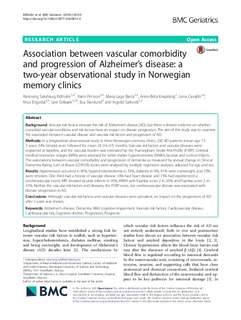| dc.contributor.author | Eldholm, Rannveig Sakshaug | |
| dc.contributor.author | Persson, Karin Ester Torun | |
| dc.contributor.author | Barca, Maria Lage | |
| dc.contributor.author | Knapskog, Anne Brita | |
| dc.contributor.author | Cavallin, Lena | |
| dc.contributor.author | Engedal, Knut | |
| dc.contributor.author | Skovlund, Eva | |
| dc.contributor.author | Saltvedt, Ingvild | |
| dc.contributor.author | Selbaek, Geir | |
| dc.date.accessioned | 2018-05-24T06:47:32Z | |
| dc.date.available | 2018-05-24T06:47:32Z | |
| dc.date.created | 2018-05-23T08:48:37Z | |
| dc.date.issued | 2018 | |
| dc.identifier.citation | BMC Geriatrics. 2018, 18 (120), . | nb_NO |
| dc.identifier.issn | 1471-2318 | |
| dc.identifier.uri | http://hdl.handle.net/11250/2499002 | |
| dc.description.abstract | Background: Vascular risk factors increase the risk of Alzheimer’s disease (AD), but there is limited evidence on whether comorbid vascular conditions and risk factors have an impact on disease progression. The aim of this study was to examine the association between vascular disease and vascular risk factors and progression of AD. Methods: In a longitudinal observational study in three Norwegian memory clinics, 282 AD patients (mean age 73. 3 years, 54% female) were followed for mean 24 (16–37) months. Vascular risk factors and vascular diseases were registered at baseline, and the vascular burden was estimated by the Framingham Stroke Risk Profile (FSRP). Cerebral medical resonance images (MRIs) were assessed for white matter hyperintensities (WMH), lacunar and cortical infarcts. The associations between vascular comorbidity and progression of dementia as measured by annual change in Clinical Dementia Rating Sum of Boxes (CDR-SB) scores were analysed by multiple regression analyses, adjusted for age and sex. Results: Hypertension occurred in 83%, hypercholesterolemia in 53%, diabetes in 9%, 41% were overweight, and 10% were smokers. One third had a history of vascular disease; 16% had heart disease and 15% had experienced a cerebrovascular event. MRI showed lacunar infarcts in 16%, WMH with Fazekas score 2 in 26%, and Fazekas score 3 in 33%. Neither the vascular risk factors and diseases, the FSRP score, nor cerebrovascular disease was associated with disease progression in AD. Conclusions: Although vascular risk factors and vascular diseases were prevalent, no impact on the progression of AD after 2 years was shown. | nb_NO |
| dc.language.iso | eng | nb_NO |
| dc.publisher | BioMed Central | nb_NO |
| dc.rights | Navngivelse 4.0 Internasjonal | * |
| dc.rights.uri | http://creativecommons.org/licenses/by/4.0/deed.no | * |
| dc.subject | Cerebrovaskulære sykdommer | nb_NO |
| dc.subject | Cerebrovascular diseases | nb_NO |
| dc.subject | Demens | nb_NO |
| dc.subject | Dementia | nb_NO |
| dc.title | Association between vascular comorbidity and progression of Alzheimer's disease: a two-year observational study in Norwegian memory clinics | nb_NO |
| dc.type | Journal article | nb_NO |
| dc.type | Peer reviewed | nb_NO |
| dc.description.version | publishedVersion | nb_NO |
| dc.subject.nsi | VDP::Geriatri: 778 | nb_NO |
| dc.subject.nsi | VDP::Geriatrics: 778 | nb_NO |
| dc.source.pagenumber | 8 | nb_NO |
| dc.source.volume | 18 | nb_NO |
| dc.source.journal | BMC Geriatrics | nb_NO |
| dc.source.issue | 120 | nb_NO |
| dc.identifier.doi | https://doi.org/10.1186/s12877-018-0813-4 | |
| dc.identifier.cristin | 1586104 | |
| dc.relation.project | ExtraStiftelsen: 2011-2-151 | nb_NO |
| dc.relation.project | Samarbeidsorganet mellom Helse Midt-Norge og NTNU: 47071301 | nb_NO |
| dc.description.localcode | © The Author(s). 2018 Open Access This article is distributed under the terms of the Creative Commons Attribution 4.0 International License (http://creativecommons.org/licenses/by/4.0/) | nb_NO |
| cristin.unitcode | 194,65,30,0 | |
| cristin.unitcode | 194,65,20,0 | |
| cristin.unitname | Institutt for nevromedisin og bevegelsesvitenskap | |
| cristin.unitname | Institutt for samfunnsmedisin og sykepleie | |
| cristin.ispublished | true | |
| cristin.fulltext | original | |
| cristin.qualitycode | 1 | |

